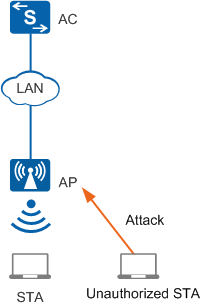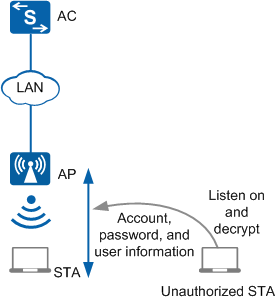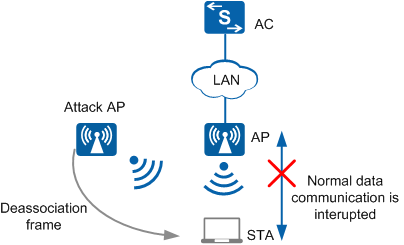Attack Detection
- Flooding attacks
- Weak initialization vector (IV) attacks
- Spoofing attacks
Flooding Attack Detection
In Figure 1, the AP receives a large number of management packets or empty data packets that have the same type and source MAC address within a short period. This is a flooding attack. As a result, the system is busy processing these attack packets and cannot process packets from authorized STAs.
Flooding attack detection allows an AP to monitor the traffic volume of each STA to prevent flooding attacks. When the traffic of a STA exceeds the allowed threshold (for example, the AP receives more than 100 packets from a STA within 1 second), the AP considers this STA to be flooding packets and reports an alarm to the AC. If a dynamic blacklist is configured, the AP adds the detected device to the dynamic blacklist and discards all of the packets from the attack device until the dynamic blacklist expires.
- Authentication Request
- Deauthentication
- Association Request
- Disassociation
- Reassociation Request
- Probe Request
- Action
- EAPOL Start
- EAPOL-Logoff
Weak IV Detection
In Figure 2, when WEP encryption is used, a STA uses a 3-byte IV and a fixed shared key to encrypt each packet to be sent so that the same shared key generates different encryption effects. If the STA uses the weak IV (the first byte of the IV ranges from 3 to 15 and the second byte is 255), attackers can easily decrypt the shared key and access network resources because the IV of the packet sent by the STA is sent in plain text as one part of the header.
Weak IV detection identifies the IV of each WEP packet to prevent attackers from decrypting the shared key. When the AP detects a packet carrying a weak IV, the AP sends an alarm to the AC so that users can use other security policies to prevent STAs from using the weak IV for encryption.
Spoofing Attack Detection
In Figure 3, an attacker (a rogue AP or malicious user) forges an authorized user' information to send spoofing attack packets to STAs, which then fail to go online. This is a spoofing attack, which is also called man-in-the-middle attack. Spoofing attack packets includes broadcast Disassociation packets and Deauthentication packets.
After the spoofing attack detection function is enabled, an AP checks whether the source MAC address of a packet is its MAC address when receiving either of the two types of packets. If so, the WLAN is under the spoofing attack of Disassociation or Deauthentication packets.


